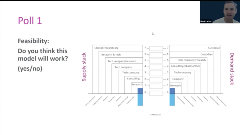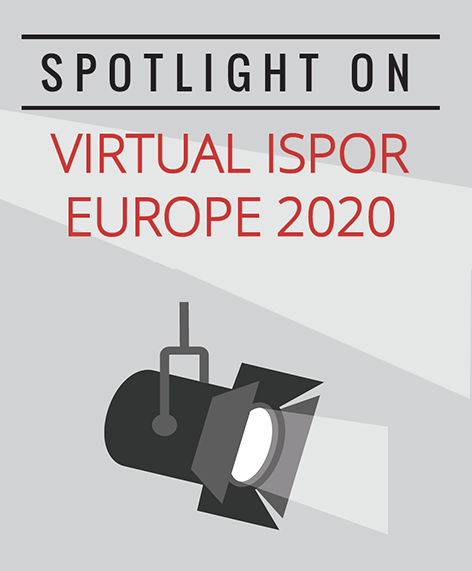The Digital Endpoints Ecosystem and Protocols (DEEP) Initiative
Aakash Bipin Gandhi, BPharm, Department of Pharmaceutical Health Services Research, University of Maryland, Baltimore, MD, USA; and Vasco Pontinha, MPharm, MA, Department of Pharmacotherapy and Health Outcomes, Virginia Commonwealth University School of Pharmacy, Richmond, VA, USA
Mark Larkin, PhD, Vitaccess Ltd, Oxford, UK moderated an exciting session aimed at introducing the audience to the Digital Endpoints Ecosystem and Protocols (DEEP) initiative that was founded with the purpose of developing novel clinical endpoints for clinical trials. Marc Walton, MD, PhD, Janssen Research and Development, Janssen, Titusvile, NJ, USA kicked off the session with a focused discussion on clinical trial or efficacy endpoints that are based on clinical outcome assessments (COAs). Walton stated that “The characteristics of a good clinical endpoint include having good reliability, sensitivity, and interpretability.” Walton highlighted the importance of being able to capture a meaningful representation of how a patient feels or functions in any COA. Clinical outcome assessments can help establish endpoints for diseases without any indicated treatments, disease characteristics that we are unable to examine, or diseases where endpoints require a degree of specificity and sensitivity. COAs that are currently used in clinical trials include features of feeling, function, or survival that are direct (eg, Brief Pain Inventory scores), mildly or very indirect (eg, Pulmonary Function test), and highly indirect (biomarkers).
“The characteristics of a good clinical endpoint include having good reliability, sensitivity, and interpretability.”—Marc Walton, MD, PhD
Promises Made, Promises Kept
After a brief introduction on COAs Walton then spoke about the promise offered by digital endpoints. “Digital endpoints such as mobile sensors offer an opportunity to measure features or effects of a disease that have previously not been well measured or not been measured at all (eg, Parkinson disease arm tremor).” As digital endpoints have multiple components, the reliability of these COA tools depend on the reliability of each of these components. An advantage of utilizing digital endpoints is that they are sensitive to small amounts of change. Thus, even treatments that have a modest effect can be reliably measured. However, this raises a question of interpretation around the clinical significance of any outcome measured by digital endpoints on a patient’s function. Dr. Walton emphasized that “There are several tasks involved in developing and maintaining a COA for generating an endpoint.” Once we get a digital endpoint measurement it is obtained, it is important to transform to a valuable outcome assessment that is understandable. This will require the involvement of individuals across different realms of expertise such as regulators, physicians, payers, and patients.
Kai Langel, BSc, Janssen Research and Development, Janssen, Titusvile, NJ, USA provided an overview of what the digital endpoint ecosystem and protocols (DEEP) looks like and how it could be implemented. In short, DEEP refers to a marketplace and service protocols in which digital measures (endpoints) are developed, assessed, adopted, and reused across different entities in health sciences (larger than pharmaceutical industry). Kai predicted that “digital measurements will be the next big boom in clinical trials, with huge growth in the next 5 years and beyond."
For that to happen, the status quo environment needs to be leveraged so that the current landscape is coded into strategic service designs and different stakeholders (pharmaceutical company, tech companies, healthcare professionals) are able to communicate with each other. The actual implementation of such a marketplace is dependent on the ability of making different moving parts come together. For example, the life cycle of digital products ranges from 1-3 years. Alternatively, the clinical development life cycle averages about 10 years. This means that testing one particular piece of technology using the traditional clinical development life cycle means absolute obsolescence by the time it is able to be implemented in the real world. Therefore, Kai argues that the standardization to establish equivalence is key: researchers must be able to upgrade the devices without having to start everything from scratch.
“Digital measurements will be the next big boom in clinical trials, with huge growth in the next 5 years and beyond.”—Kai Langel, BSc
DEEP is a two-sided concept: it allows to create a marketplace in which technologies and services can be exchanged, but it also requires some form of asset trading. The latter, Kai argues, is something that might be foreign to the pharmaceutical industry. Traditionally, the pharmaceutical industry is relatively closed, and it is not used to working as a cluster of industry and service providers, like the auto industry, for example.
So, How Does One Begin to Build This DEEP?
Following an “endpoint development stack model” might be a good start. Using the approach, one is able to prioritize each milestone with the respective partners or stakeholders to make it happen (Figure 1). Mark Larkin, PhD, Vitaccess Ltd, Oxford, UK discussed how this stacked approach allows the company to identify areas of interest that might be interesting to other stakeholders, the same way that the sharing of assets allows the company to identify areas that others are working on. He concluded by providing two examples of how DEEP can become a reality: activities of daily living and healthcare resource utilization. The large audience seemed to largely agree with the feasibility of DEEP but displayed some reservations about whether all the relevant stakeholders had been identified.
Figure 1: Stacked model to develop digital endpoints

HTA Perspective on DEEP
For Sheela Upadhyaya, Dip, Independent HTA perspective, London, United Kingdom, the use of digital endpoints creates an opportunity to generate better and richer evidence that is closer to the patient. In true real-world evidence fashion, digital endpoints are likely to complement and augment clinical data, “painting a better picture of what’s actually happening with the disease and the patient.”However, for Sheela, the word of order is validation. Because HTAs need to make decisions in terms of how much is paid for how gained health, the ability to create valid, reliable, and reproducible digital endpoints is critical for the complete buy in of HTA agencies. Ultimately, developers of digital endpoints need to demonstrate how those endpoints relate with Health-related Quality of Life (ED-5D). With this connection established, HTA agencies might find themselves in a more comfortable position to consider assessments using digital endpoints. For Sheela, digital endpoints and the marketplace that ensues seems to be a good strategy to increase the way diseases are understood, while increasing the efficiency for companies and HTA/payers, which ultimately may speed up HTA decisions and patients’ access to treatments.

